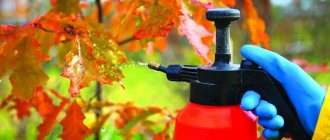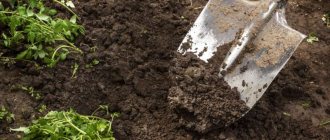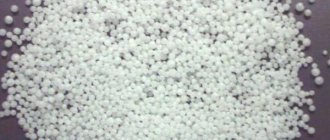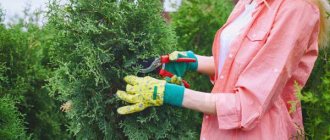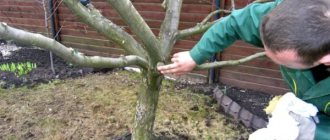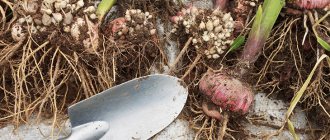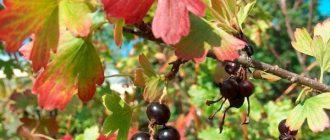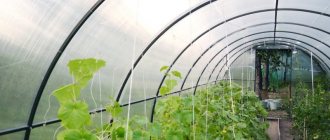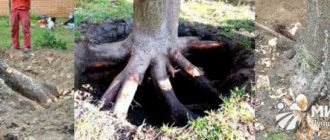In autumn, it's time to take care of the condition of your plot and garden. Creating comfortable overwintering conditions for fruit trees is the primary task of gardeners. What does garden care include in the fall? On the eve of the winter cold, after the leaves have completely fallen off, you can begin sanitary pruning, thinning, and reducing the crowns of perennial trees to 4-4.5 m. It is better to postpone detailed anti-aging pruning until spring. Why? Firstly, there are concerns about the possibility of trees freezing. Secondly, places where perennial branches of large diameter have been cut can become a source of frost damage even when treated with garden varnish or oil paint.
In the fall, a thorough inspection of fruit trees is carried out, dry, damaged branches are removed. Along with the removal of diseased, dry branches, trees are cleaned of fruits that have dried on the branches, nests and egg-laying pests are burned, growth is cut out, leaf litter and root shoots are removed, where many types of aphids have accumulated.
Protecting fruit trees from rodents
All this must be destroyed immediately. When cuts with a diameter of more than 2 cm are formed, they are covered with garden pitch. The trunks of young trees are tied along the entire length with a special non-woven material or other available means to protect against damage by mouse-like rodents with the tying material being buried 3-5 cm into the soil.
For example, I do this. I wrap young trees with narrow bandages cut from spunbond or lutrasil. And then I start digging - the ends of the bandage are buried in the earth, as if buried.
When to dig up the trunk circle of trees?
Most fruit growers are for keeping the tree trunk clean and for digging it up, that is, for black steam under an apple or pear tree, cherry or plum, and so on. At the same time, a one-time digging of the soil will not solve much; it is better to do it four or even five times during the season.
Usually, tree trunk circles are dug up for the first time in early spring, when the snow melts and the soil warms up . Digging at this time allows the soil to quickly warm up to a greater depth, and then it is enough to wait a week, let it warm up thoroughly, and you can safely mulch it with a layer of compost a couple of centimeters deep, giving the plants additional nutrition. In addition, compost, which has become forgotten, will inhibit the growth of weeds, reduce moisture evaporation, and reduce further overheating of the soil. You can also combine digging up the soil with composting and adding fertilizers, for example, nitroammophoska in liquid form (a tablespoon per bucket of water and a couple of liters per tree).
At the same time, try to dig up the soil not right next to the trunk (with stone fruits it is generally dangerous to do this, there is a sensitive root collar: moisture will collect and the neck will begin to rot), because here, basically, there are thick roots that hold the plant, and a little further away, on 12-15 cm from the trunk (absorbing roots, the most active ones, are often located in this zone). The benefit from such (correct) digging will be maximum.
Important ! When digging the soil around a tree, place the shovel on its edge (along the direction of root growth, and not across their growth path), this is the only way to minimize the risk of injury to the tree’s root system.
Carry out the second digging of the soil in mid-summer , combine it with the application of potassium sulfate (15-20 g per square meter, also better in liquid form), removing weeds and, if necessary, watering (a couple of buckets under the tree). Then you can mulch with 0.5 kg of compost for each tree (after digging).
Important ! When adding raw compost to stone fruit plants, try to move 2-3 centimeters away from the root collar to avoid damping off; under no circumstances should you pile fertilizers, including other types of mulch, on it.
The need for a third digging is usually determined as the tree trunk becomes clogged with weeds and the soil is compacted ; weeds are also removed and fertilizers are applied, but this time wood ash (a source of potassium and microelements, like soot) or soot, 250-300 g for each plant . You can also mulch the plants with compost, a kilogram for each.
Processing of trees, shrubs, grapes
On stone fruits, against diseases in the fall, you can treat them with copper preparations, for example, Bordeaux mixture, and on pome trees, with Preparation 30. Treatment with Preparation 30 can be postponed until the spring. Pass it over the swelling buds.
In the vineyard, the plants are also carefully inspected after harvest. Before sheltering for the winter, be sure to take care of keeping the plants in a healthy condition. If the presence of the leaf form of phylloxera has been noticed, it is necessary to treat the swelling buds with Preparation 30 in early spring. Unripe shoots must be cut out in the fall. If shoots affected by anthracnose are noticed, in the fall or early spring the bushes are treated with 3% Bordeaux mixture - this is one of the universal fungicides that has the longest protective effect.
Feed
What should you do in the garden in the fall?
Be sure to feed the trees. Why is this needed? In autumn, plants store nutrients for the winter. And the more they accumulate, the easier it will be for them to endure unfavorable weather. However, at this time there are very few nutrients in the soil - everything was used up in the summer. Therefore, autumn fertilizing must be done.
How to do it. Each fruit plant has its own time and norms of fertilizing (doses are indicated for 1 plant).
Apple and pear trees are fertilized immediately after harvesting: 1.5 cups of superphosphate and 1 cup of potassium sulfate.
Plum and cherry plum - after harvesting the fruits: 3 tbsp. spoons of superphosphate and 2 tbsp. spoons of potassium sulfate.
Cherries and cherries - at the end of September: 1 glass of superphosphate and 3 tbsp. spoons of potassium sulfate.
Currants - at the end of September - beginning of October: 0.5 cups of superphosphate and 1 cup of potassium sulfate.
Gooseberries - late September - early October: 1.5 tbsp. spoons of superphosphate and 4 tbsp. spoons of potassium sulfate.
It is also useful to sprinkle the tree trunk circles with humus or compost - they also increase the winter hardiness of plants. Organic matter is added to berry fields every year, and to fruit trees - once every 3-4 years.
But under no circumstances should you add mineral nitrogen and fresh manure in the fall! They delay the aging of wood, which greatly reduces winter hardiness.
Feeding fruit trees
In late autumn, apply organic, organomineral or mineral phosphorus-potassium fertilizers - superphosphate, potassium sulfate, etc., 6-9 g of active substance per 1 m2. Fertilizers are applied into holes or wells 20-30 cm deep into the area of tree trunks at a distance of 0.5-1 m outside the crown projection or under digging. One or two holes or boreholes are made on each square meter.
For orchards, long-acting fertilizers are most important. The main ones are organic and organomineral fertilizers. Nutrients from them are released slowly as they are decomposed by microorganisms. The composition of organic fertilizers (manure, composts, etc.) includes the entire set of nutrients necessary for perennial fruit and berry plants, as well as hormones, vitamins, etc. Their application affects the growth and productivity of trees for 3-5 years, while the productivity increases to 25 and even 50 percent.
Organo-mineral fertilizers include both organic (peat, humates, etc.) and mineral fertilizers.
According to the Institute of Horticulture and Viticulture, in the fourth year after applying mixed fertilizers (organic and mineral) under a fruit-bearing apple tree (to a depth of 15-18 cm), the content of nitrogen, phosphorus, and potassium available to the plant in the soil at a depth of up to 60 cm is several times higher keeping them in non-fertilized areas of the garden. This is due to the fact that fertilizers applied locally during the autumn digging of the garden by 2/3 of a shovel are localized in the application zone, creating nutritional centers within the boundaries of the main distribution of the root system of perennial plants.
In addition, in areas of the garden or vegetable garden where organo-mineral fertilizers were used when digging the soil, you can also notice that the soil has become looser and crumbles well. This means improving its agrophysical properties.
When using fertilizers in the fall, it must be remembered that the application of fast-acting species can lead to the activation of growth processes in trees against the backdrop of warm weather and a sufficient amount of moisture in the soil, which will cause serious damage in winter due to low negative air temperatures.
For autumn refilling of the garden soil in late autumn (November), as a rule, phosphorus-potassium fertilizers (nitrophoska, nitroammofoska) are used, and in earlier periods (October) ammonium forms of nitrogen fertilizers (ammonium sulfate, ammonium nitrate) can be applied. In this case, the dose of nitrogen fertilizers is divided: in the fall, 1/3-1/2 doses are applied; in early spring, 2-3 weeks before the trees flower, apply intra-soil fertilizing with fast-acting nitrogen fertilizers (1/2-1/3 of the main dose); in the summer, the remaining dose of nitrogen is added with irrigation water.
Autumn filling of the soil with fertilizers contributes to the formation of resistance of fruit plants to unfavorable environmental conditions, since the winter hardiness of trees is determined to a large extent by how many nutrients they accumulate in preparation for winter and to what extent these substances turn into protective substances. A prerequisite for sufficient accumulation of reserve nutrients is the optimization of the nutritional regime of fruit plants, which allows for dynamic growth of all organs, withstanding spring temperature changes, blooming profusely in winter and forming a full-fledged harvest.
Is it necessary to dig up fruit trees in the fall?
1:502
In autumn, it's time to take care of the condition of your plot and garden. Creating comfortable overwintering conditions for fruit trees is the primary task of gardeners.
What does garden care include in the fall? On the eve of the winter cold, after the leaves have completely fallen off, you can begin sanitary pruning, thinning, and reducing the crowns of perennial trees to 4-4.5 m.
It is better to postpone detailed anti-aging pruning until spring. Why? Firstly, there are concerns about the possibility of trees freezing.
Secondly, places where perennial branches of large diameter have been cut can become a source of frost damage even when treated with garden varnish or oil paint.
In the fall, a thorough inspection of fruit trees is carried out, dry, damaged branches are removed. Along with the removal of diseased, dry branches, trees are cleaned of fruits that have dried on the branches, nests and egg-laying pests are burned, growth is cut out, leaf litter and root shoots are removed, where many types of aphids have accumulated.
1:2283
↑
1:35
Caring for fruit trees in autumn
It may seem that after harvesting, there is nothing left to do in the garden until next spring. The trees shed their leaves and go into hibernation, the garden beds are cleared.
Winter is coming - a time of rest and garden maintenance is no longer required. But caring for fruit trees in the fall takes up all the gardener’s time until winter.
You don’t need to garden every day, but all three months before the onset of winter.
How to care for fruit trees in autumn
Autumn care for fruit trees begins almost in August. The plant must have time to prepare for wintering, and for this it needs to be harvested.
While the fruits are hanging on the tree, the processes of preparing for winter do not start. If the climate allows, the process of caring for fruit crops can be distributed monthly.
If the garden is large, then this distribution will be optimal.
September
Procedures to be done in September:
- harvest;
- remove hunting belts from trunks;
- collect all the carrion from the ground;
- carry out sanitary pruning;
- pour potassium permanganate solution onto tree trunk circles;
- treat tree trunks with copper oxychloride.
By autumn, the fruits remain only on apple and pear trees, but it is advisable to remove them before September 10.
Late-ripening varieties of apples can be removed by the end of the month, then all care procedures will have to be carried out a little later.
The time between gardening works will need to be compacted, but in the northern regions it is often necessary to do everything almost simultaneously in order to finish caring for fruit crops by mid-October.
Hunting belts against ants and other flightless pests are removed, since the insects are already beginning to hibernate, and the protection will interfere with the care of tree trunks. Carrion is picked up from the ground. Mold spores from rotting fruit can get onto the tree and cause fruit rot the following year.
During the period when trees are preparing for winter, but the leaves have not yet fallen, drying out and diseased branches are clearly visible. After general “tidying up” of the garden, sanitary pruning is done. There are two opposing positions regarding autumn formative pruning.
Some gardeners believe that everything should be postponed until spring. Others are convinced that autumn is the best time to form the crown and remove excess shoots.
But formative pruning and crown thinning are best done after leaf fall, when all the shoots are clearly visible and you don’t have to wade through the foliage.
How often should you dig up trees? and what?
There will be additional space for a recreation area: place a table and a bench on the green grass under a tree, where you can hide in the summer heat!
What are the disadvantages we have:
1. Pests and pathogens will be able to survive.
They will overwinter well in undisturbed soil, and in the spring you will have to treat the plants with chemicals. But if you constantly look after the garden and do not forget about preventing diseases and pests, then this, in fact, is not a problem. In addition, beneficial insects can also survive in the soil, which will help you fight harmful ones.
2. Loss of usable area.
On the other hand, no matter how much land you give to a summer resident, he will still not have enough. And the lawn under the tree can also be used for planting. For example, mark out bulbous plants there: snowdrops, pushkinia, corydalis, hellebores or daffodils.
What is the conclusion:
As you can see, the option when grass grows under a tree has much more advantages. So it makes sense to abandon steam in favor of meadow.
In this case
in the tree trunk circle you can create a man-made lawn. Lawn grasses such as bentgrass, clover and other ground cover plants grow well under the trees. They can be sown from spring to September and even before winter.
Among the countless varieties and hybrids of sweet peppers, there are those, such as the Ramiro pepper, whose popularity is literally worldwide. And if most vegetables on supermarket shelves are nameless, and it is almost impossible to find out about their variety, then the name of this pepper “Ramiro” will certainly be on the packaging. And, as my experience has shown, this pepper is worth letting other gardeners know about it. In connection with which this article was written.
Autumn is the most mushroom time. It is no longer hot, and heavy dew falls in the mornings. Since the earth is still warm, and foliage has already attacked from above, creating a completely special microclimate in the ground layer, the mushrooms are very comfortable. Mushroom pickers are also comfortable at this time, especially in the mornings when it is cooler. It's time for both to meet.
If you are a busy person, but at the same time not devoid of romance, if you have your own plot and are endowed with aesthetic taste, then explore the opportunity to purchase this wonderful ornamental shrub - karyopteris, or Nutwing. He is also “wing-hazel”, “blue fog” and “blue beard”. It truly fully combines unpretentiousness and beauty. Karyopteris reaches its peak of decorativeness in late summer and autumn. It is at this time that it blooms.
Pepper ajvar - vegetable caviar or thick vegetable sauce made from bell peppers and eggplants. The peppers for this recipe are baked for quite a long time, then they are also stewed. Onions, tomatoes, and eggplants are added to ajvar. To store eggs for the winter, they are sterilized. This Balkan recipe is not for those who like to make preparations quickly; undercooked and underbaked ajvar is not about it. In general, we approach the matter in detail. For the sauce, we choose the ripest and meatiest vegetables on the market.
We suggest you familiarize yourself with Red house ants in an apartment: how to get rid of the parasite?
Despite the simple names (“sticky” or “indoor maple”) and the status of a modern substitute for indoor hibiscus, abutilons are far from the simplest plants. They grow well, bloom profusely and provide a healthy look of greenery only in optimal conditions. On thin leaves, any deviations from comfortable lighting or temperatures and disturbances in care quickly appear. To reveal the beauty of abutilons in rooms, it is worth finding the ideal place for them.
Zucchini fritters with Parmesan and mushrooms - a delicious recipe with photos of available products. Ordinary zucchini pancakes can be easily turned into a non-boring dish by adding a few savory ingredients to the dough. During the squash season, pamper your family with vegetable pancakes with wild mushrooms; it is not only very tasty, but also filling.
The idea of growing vegetables on the grass, under the grass and in the grass is scary at first, until you become imbued with the naturalness of the process: in nature, this is exactly how everything happens. With the obligatory participation of all soil living creatures: from bacteria and fungi to moles and toads. Each of them contributes. Traditional tillage with digging, loosening, fertilizing, and fighting all those we consider pests destroys the biocenoses that have been created over centuries. In addition, it requires a lot of labor and resources.
What to do instead of a lawn? So that all this beauty does not turn yellow, does not get sick and at the same time looks like a lawn... I hope that the smart and quick-witted reader is already smiling. After all, the answer suggests itself - if you do nothing, nothing will happen. Of course, there are several solutions that can be used, and with their help, you can reduce the area of the lawn, and therefore reduce the labor intensity of caring for it. I propose to consider alternative options and discuss their pros and cons.
Tomato sauce with onions and sweet peppers - thick, aromatic, with pieces of vegetables. The sauce cooks quickly and is thick because this recipe contains pectin. Make such preparations at the end of summer or autumn, when the vegetables have ripened in the sun in the garden beds. Bright, red tomatoes will make equally bright homemade ketchup.
This year I often observed a picture: among the luxurious green crown of trees and shrubs, here and there, like candles, the bleached tops of shoots “burn.” This is chlorosis. Most of us know about chlorosis from school biology lessons. I remember that this is a lack of iron... But chlorosis is an ambiguous concept.
Korean vegetables for the winter - delicious Korean salad with tomatoes and cucumbers. The salad is sweet and sour, spicy and slightly spicy because it is prepared with Korean carrot seasoning. Be sure to prepare a few jars for the winter; in cold winter, this healthy and aromatic snack will come in handy. You can use overripe cucumbers for the recipe; it is better to harvest vegetables in late summer or early autumn, when they are ripe in the open ground under the sun.
Autumn for me means dahlias. Mine begin to bloom as early as June, and all summer the neighbors peek at me over the fence, reminding them that I promised them a few tubers or seeds by the fall. In September, a tart note appears in the aroma of these flowers, hinting at the approaching cold. This means it’s time to start preparing the plants for the long, cold winter. In this article I will share my secrets of autumn care for perennial dahlias and preparing them for winter storage.
To date, through the efforts of breeders, according to various sources, from seven to ten thousand (!) varieties of cultivated apple trees have been bred. But despite their enormous diversity, in private gardens, as a rule, only a couple of popular and beloved varieties grow. Apple trees are large trees with a spreading crown, and you cannot grow many of them in one area. What if you try to grow columnar varieties of this crop? In this article I will tell you exactly about these varieties of apple trees.
Pinjur - Balkan-style eggplant caviar with sweet peppers, onions and tomatoes. A distinctive feature of the dish is that the eggplants and peppers are first baked, then peeled and simmered for a long time in a Dutch oven or in a thick-bottomed pan, adding the rest of the vegetables specified in the recipe. The caviar turns out to be very thick, with a bright, rich taste. In my opinion, this cooking method is the best known. Although it is more troublesome, the result compensates for the labor costs.
“Hello, dear editors of Smart Economy!
Thank you for such a useful newspaper for us, simple and hardworking people who love the earth and plants. I want to tell you about my garden and share my experience of digging up trees.
I have more than 10 fruit trees in my garden. I pay a lot of attention to them, because they, like any person, require care. But not just any kind, but a very thorough one.
Bark protection
autumn treatment of trees, bark protection One of the important points of tree care is maximum protection of their bark from external influences. In spring we can detect vertical cracks in the bark. They are quite deep and cause harm to plants. Cracks occur due to temperature changes that occur in winter.
We suggest you familiarize yourself with How to cut multiflora chrysanthemum in the fall - Green World
During the day the sun burns and strongly heats the bark, but at night it is affected by severe frost. Cracks can also occur in summer under the influence of the same sun, as well as strong winds and night cold. Plant pests also participate in the formation of cracks. In order to avoid such injury to trees, they should be provided with proper care in the fall.
Also protect tree trunks from insects and rodents. This can be done with the help of special preparations, as well as a protective net, which is placed on the trunk of the plant and is guaranteed to prevent damage by rodents.
